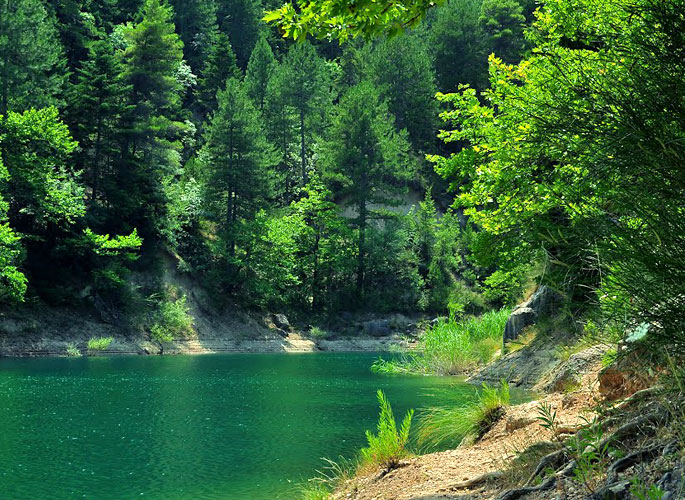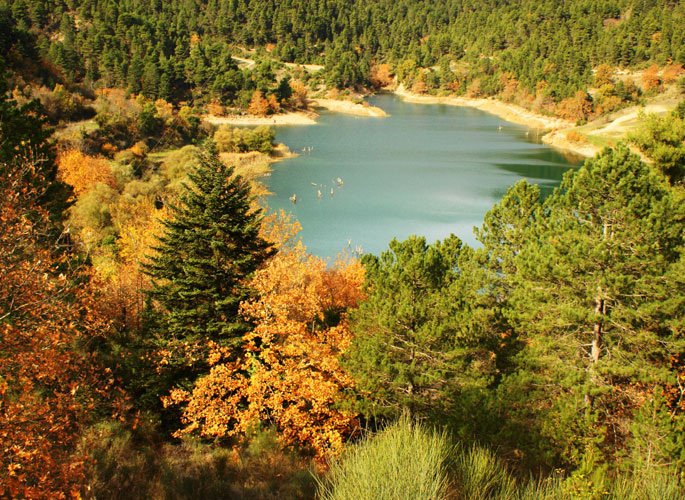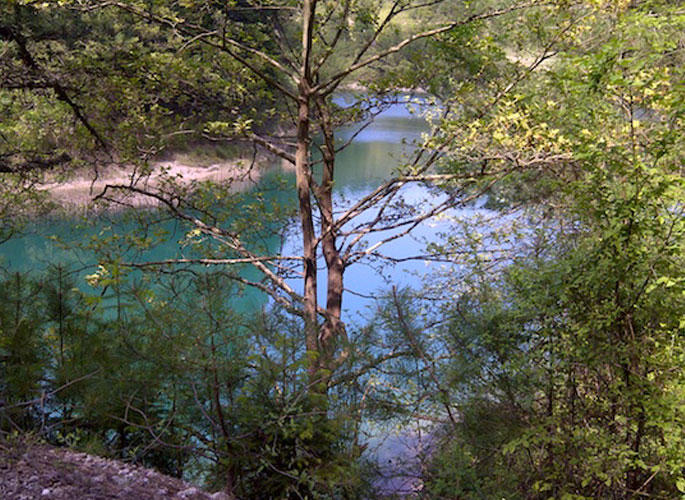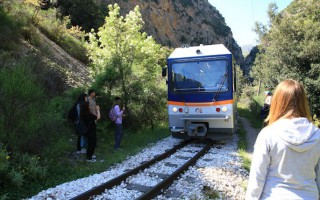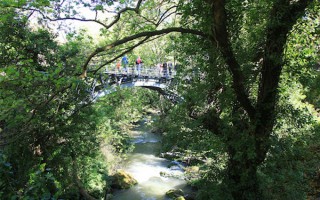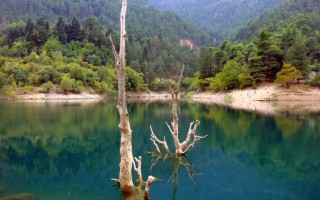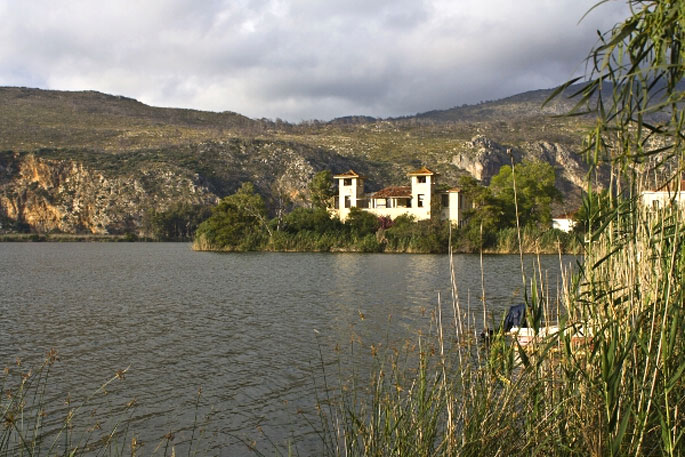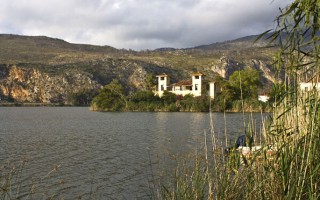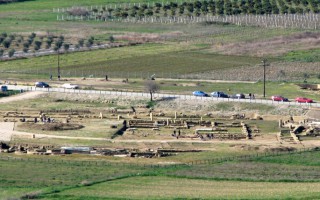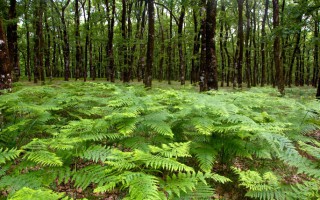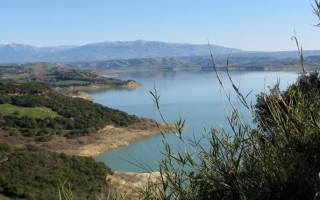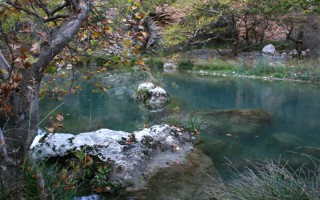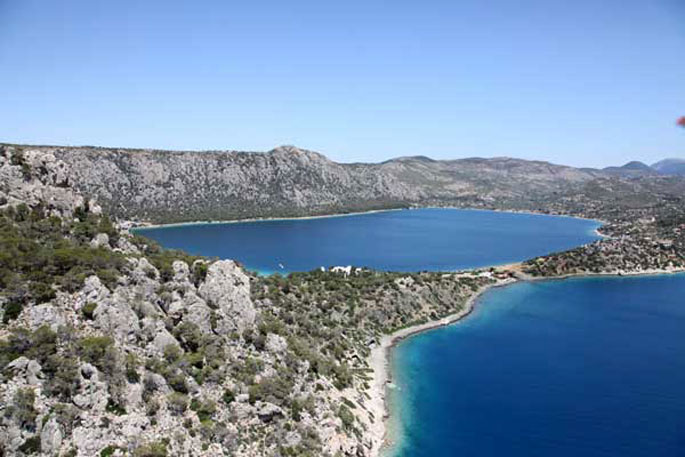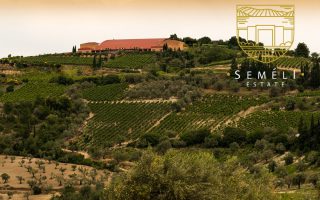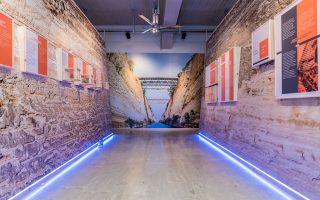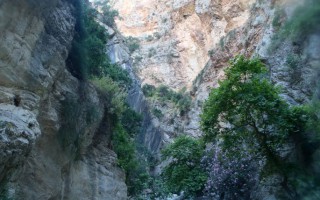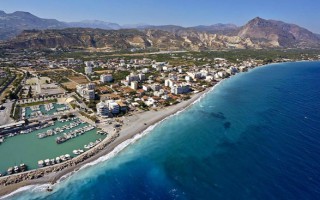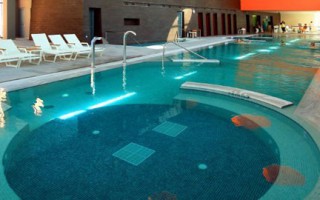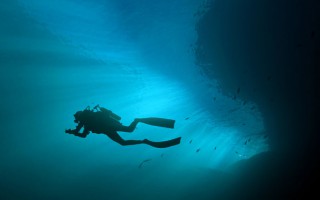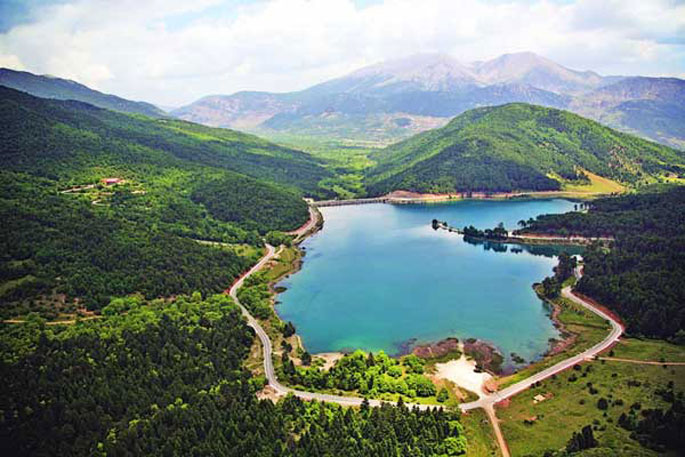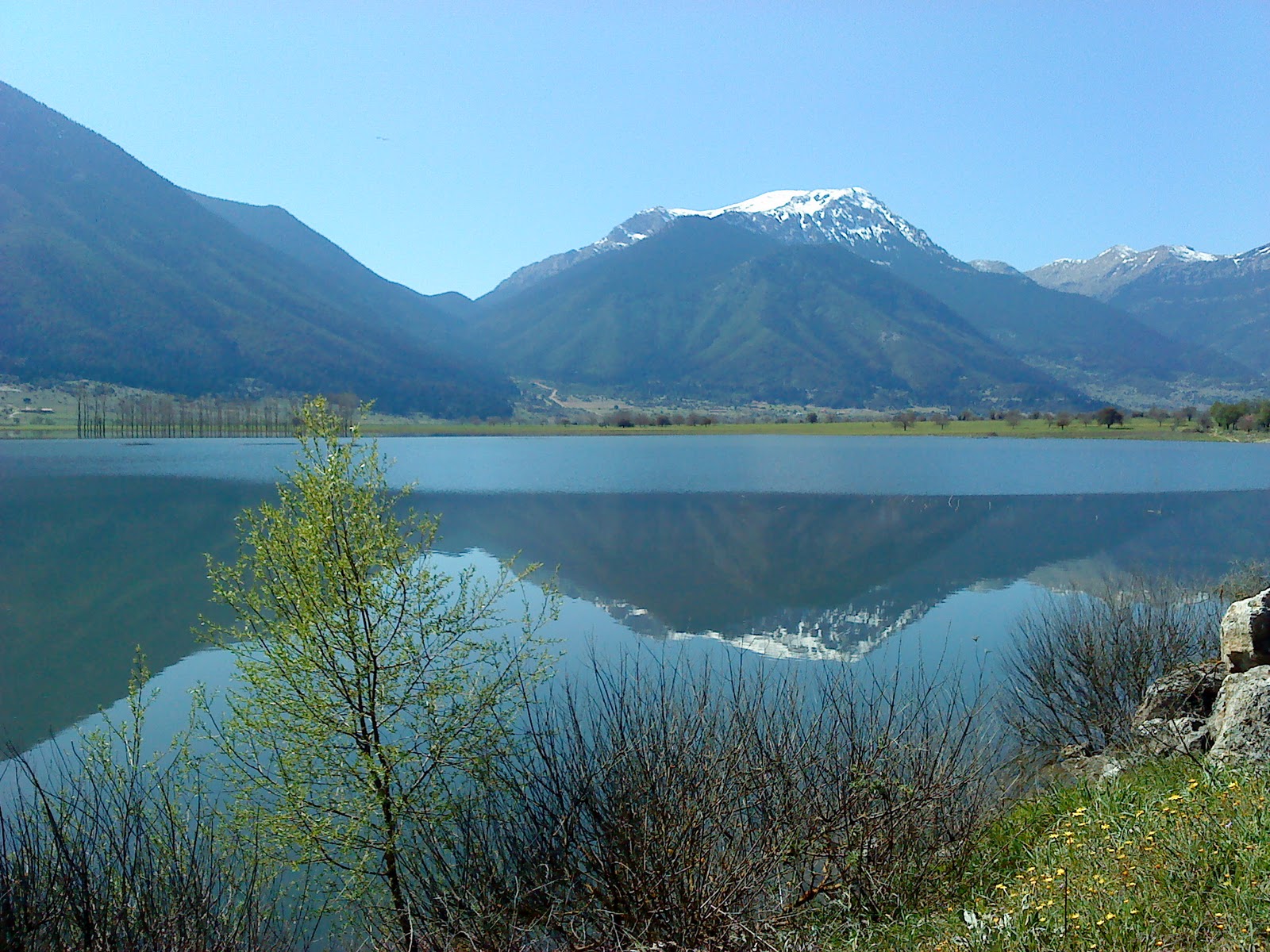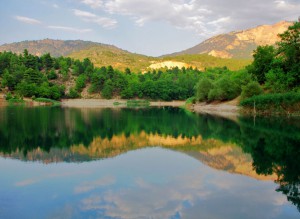 One of the few lakes in the mountainous region of the Peloponnese, lake Tsivlou is situated at an altitude of 800 m. It was formed following a landslide in 1912 when the ancient river Krathis was blocked.
One of the few lakes in the mountainous region of the Peloponnese, lake Tsivlou is situated at an altitude of 800 m. It was formed following a landslide in 1912 when the ancient river Krathis was blocked.
The small yet picturesque lake is located half way from Akrata to Zarouchla. Enjoy a picnic with view the huge branches sprouting out of its surface or chose between walking, mountain biking and off-road rides along the trail surrounding the lake.
Source: www.mythicalpeloponnese.gr
 To the west of the prefecture of Ilia, 27 km from its capital, Pyrgos, lies the area known as Kaiafas, comprising a vast beach on the side of the Ionian sea, a coastal pine forest and the homonymous lake, which is the centre of health tourism in the area. The healing properties of the Kaiafa lake waters have been known since antiquity; according to the ancient Greeks, they owed their properties to the nymphs who inhabited the forests surrounding the area. For that reason they honoured them with great piety, erecting splendid temples and sanctuaries in their name. Those visiting Kaiafas today do so not only for the water therapy, but also to admire the unique natural landscape and to do activities such as sea sports, which are offered in the area. The beautiful, serene nature also sets the scene for total relaxation, away from the city’s rapid pace.
To the west of the prefecture of Ilia, 27 km from its capital, Pyrgos, lies the area known as Kaiafas, comprising a vast beach on the side of the Ionian sea, a coastal pine forest and the homonymous lake, which is the centre of health tourism in the area. The healing properties of the Kaiafa lake waters have been known since antiquity; according to the ancient Greeks, they owed their properties to the nymphs who inhabited the forests surrounding the area. For that reason they honoured them with great piety, erecting splendid temples and sanctuaries in their name. Those visiting Kaiafas today do so not only for the water therapy, but also to admire the unique natural landscape and to do activities such as sea sports, which are offered in the area. The beautiful, serene nature also sets the scene for total relaxation, away from the city’s rapid pace.
 Kaiafas, with its lake and the unique natural landscape that surrounds it, is located on the border with the Municipality of Zacharo and comprises the huge, sandy coast traversing the entire coastal line of the bay of Kyparissia, the impressive pine forest of Strofilia, the plain of Xirochori-Zacharo and the mountain range of the mythical mountain Lapithas, on the western foot of which lies the spring of the Anigrides nymphs and on its eastern foot the spring of Geranios.The warm, healing waters of the lake are considered suitable for skin conditions, rheumatism, various conditions of the liver and asthma, and have many times been exalted by those who tried water therapy as a solution to one of the aforementioned problems. The belief in their healing properties is an ancient one; according to Pausanias, the cave that lies to the area’s west, called “the cave of the Anigrides nymphs”, was inhabited by the nymphs Kalliafeia, Pigaia and Iasis. From the first one derives the name of the area today, Kaiafas, while the names of the other two testify to the existence of healing waters (pigi = spring, iasis = cure). According to myth, Dardanos, the ancestor of the Trojans, was born in the Anigrides cave. It is also said that in this spring the Centaur Nessos washed his wounds; he had been hit by the poisonous arrows of Hercules, which explains the waters’ foul smell.
Kaiafas, with its lake and the unique natural landscape that surrounds it, is located on the border with the Municipality of Zacharo and comprises the huge, sandy coast traversing the entire coastal line of the bay of Kyparissia, the impressive pine forest of Strofilia, the plain of Xirochori-Zacharo and the mountain range of the mythical mountain Lapithas, on the western foot of which lies the spring of the Anigrides nymphs and on its eastern foot the spring of Geranios.The warm, healing waters of the lake are considered suitable for skin conditions, rheumatism, various conditions of the liver and asthma, and have many times been exalted by those who tried water therapy as a solution to one of the aforementioned problems. The belief in their healing properties is an ancient one; according to Pausanias, the cave that lies to the area’s west, called “the cave of the Anigrides nymphs”, was inhabited by the nymphs Kalliafeia, Pigaia and Iasis. From the first one derives the name of the area today, Kaiafas, while the names of the other two testify to the existence of healing waters (pigi = spring, iasis = cure). According to myth, Dardanos, the ancestor of the Trojans, was born in the Anigrides cave. It is also said that in this spring the Centaur Nessos washed his wounds; he had been hit by the poisonous arrows of Hercules, which explains the waters’ foul smell.
This hydrotherapy centre is responsible for attracting many tourists in the area, of all ages and from all over the world. The healing waters are rich in hydrogen sulphide and their temperature remains stable at 20-30 °C between May and October, which is the most suitable period for water therapy.
Kaiafas, of cource, isn’t good only for water therapy; many also come here to enjoy the enchanting landscape, with the emerald-green sea, the beach with the sand dunes and the unique vegetation surrounding the lake. It is not a coincidence that the lake has been declared a protected area. At its centre lies the islet of Aghia Ekaterini, with the small church of the same name and the Tourism Development Company’s building facilities, which include, among others, hotels and lodgings. The islet and the opposite coast are linked by a bridge, while the transition from the hydrotherapy centre to the hotel facilities and the reverse is done by boat.
For those who wish to get to know the surrounding area, there are various points of interest, such as the beaches of Kourouta and Zacharo and also other, lesser known beaches, a short distance away by car. No matter what you choose to do, it is certain that your stay in the Kaiafas area will regale you with unique images and offer you moments of complete relaxation.
Source: www.mythicalpeloponnese.gr
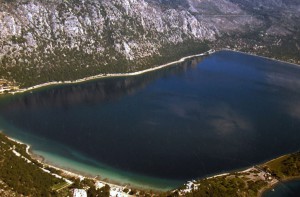 Vouliagmeni Lake is located west of the Isthmos canal, 16 kilometers from the town of Loutraki, after the village of Perachora and next to the archaeological site of Heraion. In antiquity, it was named Eschatiotis or Gorgopis after Gorgi, Corinthos’s wife, who drowned in the lake after been informed about the murder of her children.
Vouliagmeni Lake is located west of the Isthmos canal, 16 kilometers from the town of Loutraki, after the village of Perachora and next to the archaeological site of Heraion. In antiquity, it was named Eschatiotis or Gorgopis after Gorgi, Corinthos’s wife, who drowned in the lake after been informed about the murder of her children.
Video by fabdrone
It is a two kilometers wide lagoon and one kilometer long. Its depth reaches 40 meters and it is connected to the Corinthian golf by a narrow channel (width of 6 meters). It is surrounded by a pine forest which forms a magnificent landscape. Early Hellenistic settlements, that date back to 3000 B.C., have been found in the area around the lake.
Source: www.mythicalpeloponnese.gr
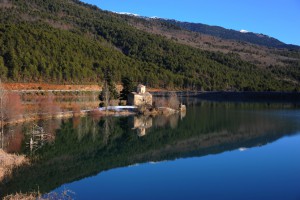 Lake Doxa is located on the borders of Sikyonion municipality, on the plateau of Pheneos. It is an artificial lake, 900 meters above sea level, completed in late 1990 with the construction of the water dam bearing the same name. In the center of the lake, on a narrow strip of land, stands the chapel of Saint Fanourios or Palaiomonastero, the remains of an old monastery that was relocated because of the floods from one of the forested slopes surrounding the lake. The new monastery of Saint George offers a magnificent view to the lake.
Lake Doxa is located on the borders of Sikyonion municipality, on the plateau of Pheneos. It is an artificial lake, 900 meters above sea level, completed in late 1990 with the construction of the water dam bearing the same name. In the center of the lake, on a narrow strip of land, stands the chapel of Saint Fanourios or Palaiomonastero, the remains of an old monastery that was relocated because of the floods from one of the forested slopes surrounding the lake. The new monastery of Saint George offers a magnificent view to the lake.
Even though it is believed that Doxa Lake is hidden among the mountains, it is easily accessed. Once in village Mossia, take the road to the left that leads to Messino village, pass through Ancient Pheneos, or Kalyvia according to the locals, and you are one kilometer away from Corinth’s small “Switzerland”.

Source: www.mythicalpeloponnese.gr
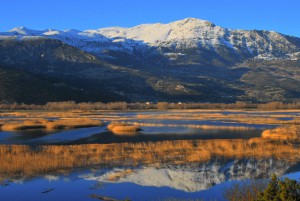 Lake Stymphalia is one of the most significant wetlands of Greece in the municipality of Sikyonion. The land is closely related to one of the most popular mythology heroes. Hercule’s sixth feat consisted of killing the Stymphalian birds, the man eating birds with bronze beaks which haunted the lake, with his arrows. According to scientists, the Stymphalian birds were inspired from the Northern Bald Ibis (Geronticus eremita).
Lake Stymphalia is one of the most significant wetlands of Greece in the municipality of Sikyonion. The land is closely related to one of the most popular mythology heroes. Hercule’s sixth feat consisted of killing the Stymphalian birds, the man eating birds with bronze beaks which haunted the lake, with his arrows. According to scientists, the Stymphalian birds were inspired from the Northern Bald Ibis (Geronticus eremita).
It is situated at an altitude of 600 meters on the plateau bearing the same name. It receives the water of the plateau’s springs and the water drained from the plateau of the reclaimed Pellene Lake.It is designated as a landmark for fauna and flora under the EU’s Natura 2000 program.
Source: www.mythicalpeloponnese.gr


